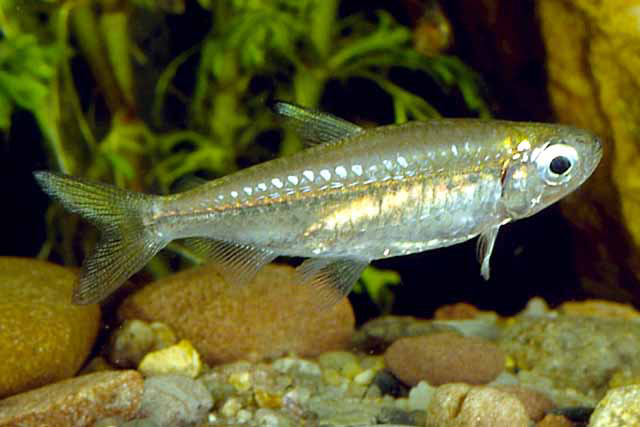| Alestidae (African tetras) |
| 6 cm TL (male/unsexed) |
|
pelagic; freshwater; pH range: 6 - 7.5; dH range: 16, potamodromous |
| Africa: found in most Sahelo-Sudanese basins of West Africa (Senegal, Volta, Niger, Chad), in the Cross River basin (Ref. 80290), in Kenya (Ref. 52871), in Sudan and South Sudan (Ref. 28714) and in Ethiopia (Ref. 58460). |
|
Anal spines: 0-0; Anal soft rays: 18-22. Diagnosis: lateral line complete, 23-29 (Ref. 81279) or 26-29 (Ref. 80290) lateral line scales. Anal fin with 3 unbranched and 15-19 (Ref. 81279) or 16-19 (Ref. 80290) branched rays. 11-14 gill rakers on lower part of first branchial arch; 6/8 premaxillary teeth (Ref. 2880, 81279). Inner dentary teeth conical, monocuspid; scales of flank without melanophores concentrated along basal margin, pigment diffuse or absent (Ref. 80290). Fins colorless, at most, pinkish; caudal fin tinged with pink (Ref. 2880, 81279). Tip of dorsal fin usually blackish (Ref. 2880, 80290, 81279). Widely distributed, never found in Cavally River (Ref. 2880, 81279).
Description: body slender; body depth 25-29% and head length 24-28% of SL (Ref. 80290). Body height 3.45-3.95x and head length 3.6-4x in SL (Ref. 42032). Mouth terminal, upper lip prominent, depth of lower jaw about 1.5 that of upper jaw; premaxilla with 3 teeth in outer row each bearing 5 cusps, 4 teeth in inner row each bearing 6-7 cusps; dentary with 4 teeth in outer row each bearing 5-7 cusps, median cusp prominent, a conical monocuspid tooth at symphysis posterior to outer row teeth; lateral line complete, 22-29 tubes, ultimate canal-bearing scale terminal (Ref. 80290). Very pronounced sexual dimorphism in male adults; anal fins curved instead of pointed (Ref. 2880, 81279).
Coloration: body silvery with glossy, brilliant longitudinal band; caudal fin tinged with carmin-pink; usually black spot at dorsal-fin tip (usually absent in very small specimens); lateral band black and appears to be broader posteriorly when preserved in formalin (Ref. 2880, 81279). |
| Inhabits fringing vegetation of rivers and lakes, feeding on zooplankton, beetles and other insects (Ref. 28714). Often reported in West Africa under name of M. acutidens.
Affinities: most similar to M. acutidens, from which it differs in the presence of conical, monocuspid (vs multicuspid) inner dentary teeth, inner premaxillary and outer dentary with fewer cusps, and a slightly more slender body (Ref. 80290). |
|
Least Concern (LC); Date assessed: 01 November 2019 Ref. (130435)
|
| harmless |
Source and more info: www.fishbase.org. For personal, classroom, and other internal use only. Not for publication.

